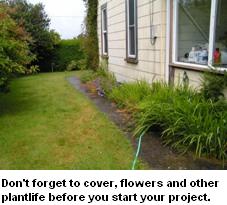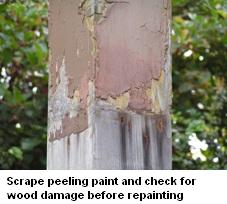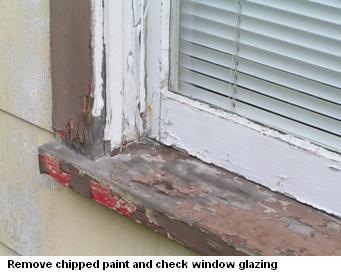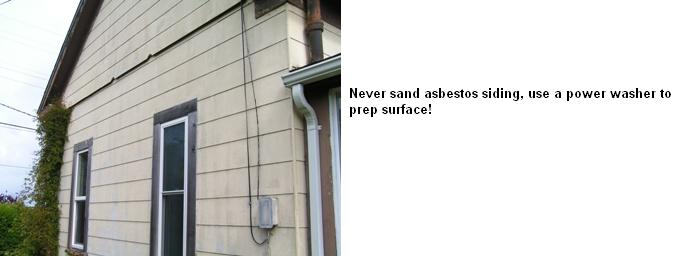
|
 |
| Articles |
 |
Painting
|
 |
Paint preparation basics
By: M. Letters, C. Hawkins
ARE YOU SICK OF looking at the dingy, lifeless color of your living room wall, or at that siding where your paint is chipping? Do-it-yourself paint jobs aren’t as trying as one might think, though they do require a little effort.
Former Dallas Cowboys Quarterback Roger Staubach said, “Spectacular achievements are always preceded by unspectacular preparation”.
When it comes to painting houses this is especially true as well.
As is true in most jobs, the preparation efforts have a major bearing on the final product. Therefore we suggest paying close attention to our recommended products and methods in order to insure you the best final results. Before you even start moving and covering the furniture, go through this basic painting preparation checklist and its steps.
|
 |
 |
 |
Advertisement
Contact me to place your ad here
|
You will need:
- Drop-sheet
Most people understand why a drop-sheet is necessary for painting, but why during the prep?
Often times during the prep phase you will be using products such as sandpaper and scrapers, which produce millions of pieces of debris. The best way to insure that your flower beds do not end up with thousands, dare I say millions of paint chips in them is to cover them.
 Drop-sheets for your interior are just as important if you plan on using caulking and spackling. Caulking and spackling presses into carpeting easier than it comes out, so be sure to cover your floor.
Drop-sheets for your interior are just as important if you plan on using caulking and spackling. Caulking and spackling presses into carpeting easier than it comes out, so be sure to cover your floor.
If you do not plan on entering the painting profession we recommend using painters’ plastic rather than professional-grade drop-sheets. It is available at most hardware stores and is inexpensive and easy to dispose of at the end of each day, or the job.
Painters’ plastic also comes in easy to manage weights and lengths. You can usually pick up enough plastic to cover 3,000 square feet for about $20, whereas professional painter drop-sheets will run you hundreds of dollars.
- Sandpaper, scraper, wire brush, spackling compound and a putty knife
Here is where the real work comes in. The time and effort you put into this phase will definitely determine the final outcome of your painting efforts and the longevity of them.
 Sanding, scraping and wire brushing are generally exterior methods for removing the peeling paint that you are sick of looking at. You can also rent yourself a power washer at the local tool rental yard if you want to expedite the process.
Sanding, scraping and wire brushing are generally exterior methods for removing the peeling paint that you are sick of looking at. You can also rent yourself a power washer at the local tool rental yard if you want to expedite the process.
Power washers are good for removing peeling paint and knocking down all the dust and cobwebs off your house. After power washing, sand the edges where the paint peeled away and left bare siding. Scrape out all the soft wood areas in your siding and then clean them before applying spackle, wood Bondo or caulking.
You can also use an exterior caulking (not silicone), which can be painted to spruce up your cracked glazing around any of your single-pane windows. Caulking also works well for filling in staple and pinholes on your interior walls.
 Rather than removing all the cracked glazing you can just apply a thin coat of caulking over your old glazing and push it into the cracks with a damp rag and then wipe it clean. Do it the same way for pin holes on your interior walls and your cracks and holes will be filled.
Rather than removing all the cracked glazing you can just apply a thin coat of caulking over your old glazing and push it into the cracks with a damp rag and then wipe it clean. Do it the same way for pin holes on your interior walls and your cracks and holes will be filled.
Doing this prevents lines where you went over your old cracked glazing. This will also help waterproof your windows in the process. Contrary to popular belief, paint does not fill all small cracks and holes, so this will also insure that you do not leave any pinholes behind.
Do not caulk over glazing that is loose or falling out. In these cases all the old glazing should be removed from around the window and then replaced.
Do not caulk over old caulking that is cracked or lifting. If an area, such as trim pieces around windows or at the corners of the structure need the caulking touched up, the old caulking should be completely removed. The best way to do this is with a razor blade. Take a razor knife and cut the caulking along any of the surfaces it is applied to, then lift and peel it out.
Before caulking any surfaces, be sure to wash them down with TSP or any other bio-degradable soap. Also, make sure to rinse it well so there is not any residue left behind.
Remember that leaking windows and doors are one of the primary places for energy loss and water leaks. So be sure that these areas are well prepped and sealed before painting.
Always keep a clean rag and some water close by just in case you do happen to make a little mess with the caulking or spackle.

- Masking tape and masking paper
Now that you have placed your drop sheets and prepped your painting surfaces, you can finish your prep by masking all the areas you do not want painted. Even if you are going to hire a contractor to paint your house you can save some extra money by prepping it ahead of time for them.
Remember paint does not stick to glass, so if you are not painting with a sprayer you can usually cut your windows in with a small brush and scrape the extra paint off with a razor blade. This will help save several hours and extra money when masking.
Otherwise, remove all screens on your windows or doors and cover all the areas you want left unpainted. Masking tape and painters’ plastic is just one method to protect your house. We recommend you ask your local paint dealer or painting contractors for other options if you feel you need them.
Exterior fixtures such as doorbells and lights can also be masked off. Some people actually remove these items, but if you are not qualified or experienced in working with either low or high voltage we do not recommend this.
Finally, if you plan on leaving your house masked, we recommend using masking tape that will not bond if it is left on a couple days.
There are several good tapes available that can be left on for weeks and do not leave behind any debris. Some people even leave these tapes on all winter, but we do not recommend this.
- Primer
There are two ways you can primer your house before painting. You can either spot primer it, which means you only primer the bare wood, metal or vinyl surfaces that will be repainted, or you can primer the entire surface.
If you do not have many major stains left behind after your initial prep work you can use the spot primer method. Also, if you do not have many large areas that are bare and need to be primed, then the spot primer method will work.
However, for the highest quality and longest lasting job we recommend a complete application of primer before painting any surface. There are many quality primers on the market for interior and exterior priming purposes and procedures.
In most cases you want to choose a good stain-blocking primer for stains and bare surfaces, whereas standard primers will work if you do not have bare surfaces. We also recommend having your primer tinted. You will have fewer streaks or patches after your initial coverage of paint and you will use less paint overall.
These are just some of the basics to help you get started on your painting endeavors. We always suggest asking your local paint dealers or contractors if you need further help clarifying what would best suit your particular project.
Safety comes first, so never do anything you do not feel is safe. Always tie off all your extension ladders when possible. Do not use step ladders like extension ladders by collapsing them and leaning them against walls or posts. Use the proper tools the proper ways and you will decrease your chances of having an accident.
You can actually save hundreds and even thousands of dollars if you do this simple prep work.
Do it now, and then take a vacation on the money you saved while someone else is painting your house.
© Central Coast Builders Inc. 2005
Used with permission
all photos by Allison Sampite and copyrighted to
Central Coast Builders Inc. 2005.
If you have any questions or comments you would like to share, please Email them to us.
Thank you!
|
|
|



 Drop-sheets for your interior are just as important if you plan on using caulking and spackling. Caulking and spackling presses into carpeting easier than it comes out, so be sure to cover your floor.
Drop-sheets for your interior are just as important if you plan on using caulking and spackling. Caulking and spackling presses into carpeting easier than it comes out, so be sure to cover your floor.  Sanding, scraping and wire brushing are generally exterior methods for removing the peeling paint that you are sick of looking at. You can also rent yourself a power washer at the local tool rental yard if you want to expedite the process.
Sanding, scraping and wire brushing are generally exterior methods for removing the peeling paint that you are sick of looking at. You can also rent yourself a power washer at the local tool rental yard if you want to expedite the process.  Rather than removing all the cracked glazing you can just apply a thin coat of caulking over your old glazing and push it into the cracks with a damp rag and then wipe it clean. Do it the same way for pin holes on your interior walls and your cracks and holes will be filled.
Rather than removing all the cracked glazing you can just apply a thin coat of caulking over your old glazing and push it into the cracks with a damp rag and then wipe it clean. Do it the same way for pin holes on your interior walls and your cracks and holes will be filled. 